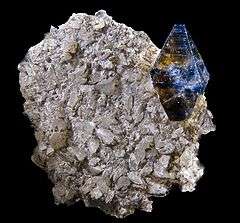Anatase
| Anatase | |
|---|---|
 | |
| General | |
| Category | Oxide minerals |
| Formula (repeating unit) | TiO2 |
| Strunz classification | 4.DD.05 |
| Crystal system | Tetragonal |
| Crystal class |
Ditetragonal dipyramidal (4/mmm) H-M symbol: (4/m 2/m 2/m) |
| Space group | I41/amd |
| Unit cell | a = 3.7845, c = 9.5143 [Å]; Z = 4 |
| Identification | |
| Formula mass | 79.88 g/mol |
| Color | Black, reddish to yellowish brown, dark blue, gray |
| Crystal habit | Pyramidal (crystals are shaped like pyramids), tabular (form dimensions are thin in one direction). |
| Twinning | Rare on {112} |
| Cleavage | Perfect on [001] and [011] |
| Fracture | Subconchoidal |
| Tenacity | Brittle |
| Mohs scale hardness | 5.5–6 |
| Luster | Adamantine to splendent, metallic |
| Streak | pale yellowish white |
| Diaphaneity | Transparent to nearly opaque |
| Specific gravity | 3.79–3.97 |
| Optical properties | Uniaxial (-), anomalously biaxial in deeply colored crystals |
| Refractive index | nω = 2.561, nε = 2.488 |
| Birefringence | δ = 0.073 |
| Pleochroism | Weak |
| References | [1][2][3] |
Anatase is one of the three mineral forms of titanium dioxide, the other two being brookite and rutile. It is always found as small, isolated and sharply developed crystals, and like rutile, a more commonly occurring modification of titanium dioxide, it crystallizes in the tetragonal system; but, although the degree of symmetry is the same for both, there is no relation between the interfacial angles of the two minerals, except in the prism-zone of 45° and 90°. The common pyramid of anatase, parallel to the faces of which there are perfect cleavages, has an angle over the polar edge of 82°9', the corresponding angle of rutile being 56°52½'. It was on account of this steeper pyramid of anatase that the mineral was named, by René Just Haüy in 1801, from the Greek anatasis, "extension", the vertical axis of the crystals being longer than in rutile. There are also important differences between the physical characters of anatase and rutile: the former is less hard (5.5–6 vs. 6-6.5 Mohs) and dense (specific gravity about 3.9 vs. 4.2). Also, anatase is optically negative whereas rutile is positive, and its luster is even more strongly adamantine or metallic-adamantine than that of rutile.
Crystal habit

Two types or habits of anatase crystals may be distinguished. The more common occurs as simple acute double pyramids with an indigo-blue to black color and steely luster. Crystals of this kind are abundant at Le Bourg-d'Oisans in Dauphiné, where they are associated with rock-crystal, feldspar, and axinite in crevices in granite and mica-schist. Similar crystals, but of microscopic size, are widely distributed in sedimentary rocks, such as sandstones, clays, and slates, from which they may be separated by washing away the lighter constituents of the powdered rock.
Crystals of the second type have numerous pyramidal faces developed, and they are usually flatter or sometimes prismatic in habit; the color is honey-yellow to brown. Such crystals closely resemble xenotime in appearance and, indeed, were for a long time supposed to belong to this species, the special name wiserine being applied to them. They occur attached to the walls of crevices in the gneisses of the Alps, the Binnenthal near Brig in canton Valais, Switzerland, being a well-known locality. Naturally occurring pseudomorphs of rutile after anatase are also known.
While anatase is not an equilibrium phase of TiO2, it is kinetically stabilized. At temperatures between 550 and about 1000 °C, anatase transforms to the equilibrium rutile phase, increasing its specific gravity to 4.2. The temperature of this transformation strongly depends on the impurities or dopants present in the material as well as on the morphology of the sample.[4]
Synthetic anatase
Crystals of anatase can be prepared in laboratories by chemical methods such as sol-gel method. Examples include controlled hydrolysis of titanium tetrachloride (TiCl4) or titanium alkoxides. Such synthetic anatases are of considerable interest for photocatalysis and for Grätzel-cell photovoltaics.
Alternate and obsolete names
Another name commonly in use for this mineral is octahedrite, a name which, indeed, is earlier than anatase, and given because of the common (acute) octahedral habit of the crystals. Other names, now obsolete, are oisanite and dauphinite, from the well-known French locality.
See also
| Wikimedia Commons has media related to Anatase. |
References
 This article incorporates text from a publication now in the public domain: Chisholm, Hugh, ed. (1911). "Anatase". Encyclopædia Britannica (11th ed.). Cambridge University Press.
This article incorporates text from a publication now in the public domain: Chisholm, Hugh, ed. (1911). "Anatase". Encyclopædia Britannica (11th ed.). Cambridge University Press.